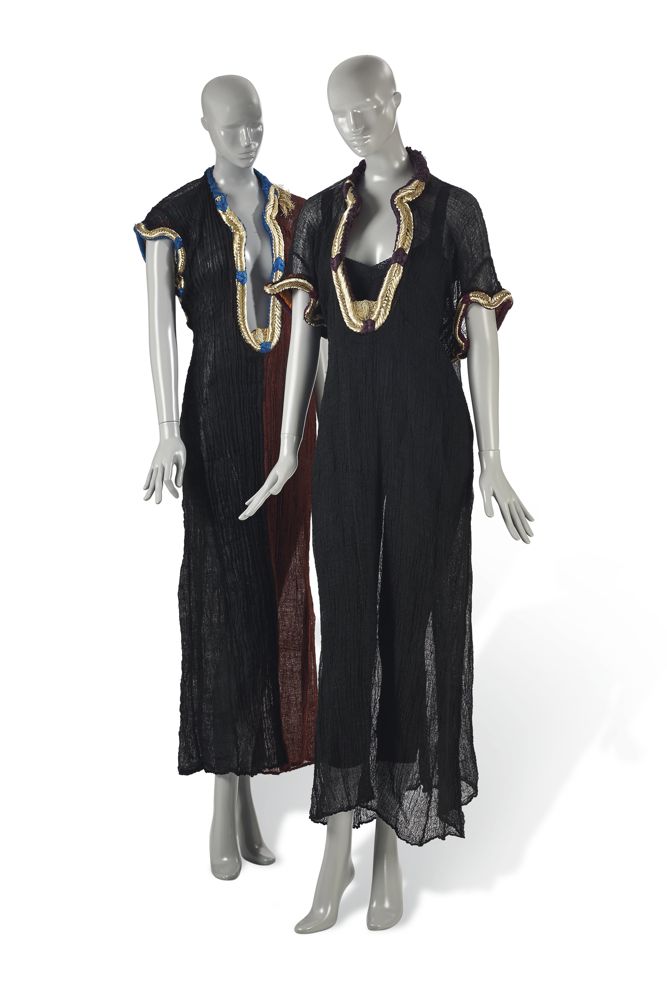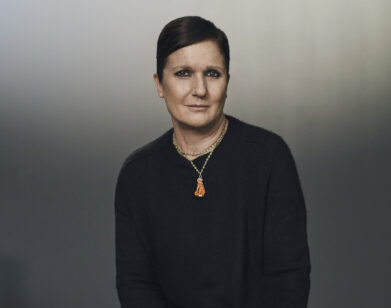The Private Life of Elsa Schiaparelli
“A bouquet of spells… a constellation of the stars… a fireworks display”: These are the analogies Yves Saint Laurent used when attempting to qualify the incomparable Elsa Schiaparelli, who rarely dabbled in the literal. Schiaparelli’s eponymous fashion house closed in 1954, and today she is perhaps better known to the public as Coco Chanel’s lifelong rival. This month, however, the Schiaparelli who dazzled at the epicenter of the Surrealist and Dadaist movements in 1930s Paris returns to the limelight. Christie’s is set to auction pieces from Schiaparelli’s private collection in Paris with the blessing of granddaughter, the iconic ’70s model Marisa Schiaparelli Berenson.
While some items are instantly recognizable from Man Ray photographs, others are new discoveries. Schiaparelli’s Chinese waistcoats are the steals of the show, starting at a mere $682; her game-changing “Astrologie” blouse, a trim violet number embroidered with golden zodiac suns that once belonged to Marlene Dietrich, is expected to start at $34,000. While Schiaparelli’s sources of inspiration ranged from cowboy vests, Japanese kimonos, and Tunisian Hammamet dresses, it was her Surrealist constructions—a lobster dress, a Jean Cocteau-backed Sleeping Beauty dinner jacket complete with embroidered golden hair—that cemented her status as a creative tour de force of idiosyncratic genius.
“I think she was really quite a rigorous thinker,” muses Pat Frost, the director of the Fashion Department at Christie’s and head of the auction’s sartorial curation. “She wasn’t just a sponge; she had a world view. She was certainly the equal of the artists and the people in her circle that she was friends with. She wasn’t a quiet member of that group.” With that in mind, an auction relieves Parisian museums from curatorial chaos while guaranteeing an audience of only true devotees. “I think it’s a question of where would you put [the pieces],” Frost agrees. “I imagine this open competition is more egalitarian.”
Over the phone, we spoke with Frost in London about the awesome process of curating the collection.
HANNAH GHORASHI: A general question to start with: how did this collection come together, and how did the idea to auction pieces from her collection originally begin?
PAT FROST: I think it’s something Marisa’s been thinking about for a while, and I think she’s gotten to a point in her life where she wants to pass on her heritage—things that she’s had from her grandmother for a long time and that she wants to share with other people. She says she has it all in her heart anyway, so she doesn’t need to hang onto the bits and bobs.
GHORASHI: How were pieces selected from her personal collection?
FROST: It was a process of physical curating, definitely. We walk through things and select things and pick out some things just because they’re fantastic. [laughs] Other things are really important from a historical point of view. So you work in a group, and from the dress point of view, it’s pretty much all there. There wasn’t really very much to exclude.
GHORASHI: Is there a specific reason the exhibition is being held in Paris?
FROST: Well, she is so much part of Paris couture, Elsa. Although she is Italian, she is also really French. And she was based in France all her life, so I think that’s sort of where it belongs. We tried to put it near the haute couture shows as a little homage to her and her adopted home.
GHORASHI: It seems like every piece has an amazing story attached, whether it was worn by Mae West or Marlene Dietrich. How much research and fact-checking did you have to do to prepare?
FROST: We’re still doing it, in a way, as there is so much that comes up if you look further. It’s like a piece of string and you keep finding vintage things on it. But certainly some things you already know, because you’ve seen them in books or you’ve seen them in photos by Man Ray—you already know the story about Mae West. I didn’t really know much about her American tour, so that’s been really interesting to read more about that.
GHORASHI: Yeah, I didn’t know she went. I wouldn’t imagine her going to Texas, but of course, she did.
FROST: And loved it, absolutely loved it. [laughs]
GHORASHI: Was everything in good condition, or did it vary?
FROST: It varied. It’s pretty much okay, actually. A couple of things that could use a stitch here and a stitch there, but it’s pretty much in decent condition.
GHORASHI: When you were putting the collection together, did you start to get a sense of her eye or her sense of taste just by her personal collection, just by the things that she collected for herself?
FROST: Yes, that is definitely the case. From our point of view, we look at all the Chinese robes and the Ottoman things that she has in her wardrobe from Turkey, and they’re thought to have relationships with things she designed in 1936 and 1937, so it’s been very interesting to see what she was inspired by and how. Because it’s these things that she lived with; she wore them to dinner every night. She always dressed for dinner. It wasn’t necessarily in her own creation. She would dress in a fantastic Chinese robe or a Japanese kimono—it’s a great thing. Marisa tells good stories about that as well, about being told off for not being fittingly dressed herself. As you know, she was a model, and she was told that miniskirts were just impossible. “Go and get dressed and immediately before supper with your grandmother!” [laughs] She was a formidable woman, her grandmother.
GHORASHI: Can you see an evolution in this collection, from things she collected when she was younger versus later on?
FROST: She was absorbing what you might call local color—local clothes, local art. I think sometimes it’s a stronger influence in the North African—she absolutely loved Tunisia, Morocco, and she was one of those early adopters of Tunisia. She built a house out there in the 1950s. So there are classical costumes, Hammamet dresses that would have been worn by Hammamet women, which also then have an influence on her sort of couture since 1938. I think it’s constant; she was always absorbing information wherever she was, and she didn’t care whether it was from the street or from the pages from a book or from an art gallery or from Dalí, it was all worked into her designs.
GHORASHI: Do you think this collection will show her to be more of an artist than a fashion designer? Or do you think she’s still primarily a designer?
FROST: I think she’s still a designer, but she’s someone that calls on the world of contemporary art and design in a really intelligent way. It’s her form of expression. It is a very blurry line, and she probably wouldn’t have thought there was any line at all. It’s all part of the same spectrum.
GHORASHI: I’m thinking about the Cocteau Sleeping Beauty jacket that had blond hair embroidered on the side.
FROST: Yes, absolutely. And the gloves with nails on them. It’s all ordinary components with unusual results. There is also a great range of buttons.
GHORASHI: Of buttons?
FROST: Of buttons. She was known for a great range of buttons. She worked with quite a lot of ceramic artists. What might appear to be an ordinary button box might actually be terra cotta buttons with a horse’s head on them.
GHORASHI: I feel as though she’d be so well received right now, because that’s what designers are doing now, they’re starting to incorporate ironic elements.
FROST: Yeah, a twist to a normal view…
GHORASHI: Do you think the collection will be the first step in bringing her more public attention? She’s not like Chanel.
FROST: She’s not, and I don’t really understand why she isn’t, to be honest. I think partly the Metropolitan retrospective last year was an unusual one in that it was Prada and Schiaparelli, so maybe not an undiluted message there. She wasn’t quite as well known as she should be, so I would hope that this would really put her in the limelight.
GHORASHI: Do you know why her fashion house closed?
FROST: Well she closed her doors in ’54, and I think the name, the name was unlicensed in the US for quite a few years, until ’73, I think, when she died. And I believe it’s about to relaunch.
GHORASHI: That’s great.
FROST: It’s really fun to see and it’s really great to see how a design icon of the ’30s, ’40s, and ’50s lived and worked. It’s great to see Marisa Berenson as well, who grew up with it.
GHORASHI: She looks quite a bit like her, actually.
FROST: [laughs] A little prettier, possibly. I mean she looks fantastic. I was just speaking to her about doing some interviews with her.
ELSA SCHIAPARELLI’S PERSONAL COLLECTION WILL BE AUCTIONED ON JANUARY 23 AT CHRISTIE’S IN PARIS. FOR MORE INFORMATION OR TO VIEW THE CATALOGUE, VISIT THE CHRISTIE’S WEBSITE.







